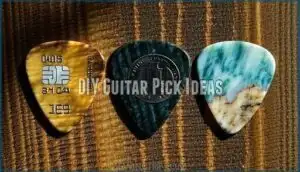This site is supported by our readers. We may earn a commission, at no cost to you, if you purchase through links.

However, you can easily craft your own picks using household items like old credit cards, coins, or thick paper.
Simply trace a teardrop shape about 1.5 inches long, cut it out, and sand the edges smooth.
Credit cards work especially well since they’re already the right thickness and flexibility.
For a quick fix, even a coin can work in a pinch, though it lacks the ideal grip.
The key is finding materials that balance flexibility with durability – too flimsy won’t produce clean notes, while too thick feels clunky.
Once you master the basic shape and discover which materials suit your playing style, you’ll discover creative possibilities that store-bought picks simply can’t match.
Table Of Contents
- Key Takeaways
- Why Use a Guitar Pick?
- Materials for Making a Guitar Pick
- DIY Guitar Pick Ideas
- How to Make a Guitar Pick Out of Paper
- DIY Guitar Pick Puncher
- The Process of Making a Guitar Pick
- Benefits of Using a Real Pick
- Alternatives to Using a Guitar Pick
- Make Your Own Guitar Pick Kit
- Where to Learn More About Guitar Playing
- Frequently Asked Questions (FAQs)
- Conclusion
Key Takeaways
- You can’t actually sew a guitar pick since picks must be rigid, but you can craft effective alternatives from household items like credit cards, coins, or thick paper by cutting them into teardrop shapes.
- Credit cards and gift cards work best as DIY picks because they offer the right thickness and flexibility – just trace a pick shape, cut it out, and sand the edges smooth for comfortable playing.
- Different materials produce unique tones and playing experiences: coins create metallic attack, paper gives softer sounds, and wood provides warm organic tones that many players prefer.
- You’ll save money and never run out of picks by making your own from recycled materials, plus you can customize thickness and shape to match your specific playing style and preferences.
Why Use a Guitar Pick?
Guitar picks transform your playing experience by giving you precise tonal control and enhanced articulation.
Unlock your guitar’s full potential with a simple pick – experience the crisp attack and tonal precision you’ve been missing.
When you strum with your fingers alone, you’re missing out on crisp attack** and consistent volume control that picks provide.
They boost your playing speed dramatically – try shredding through fast passages with just fingertips, and you’ll quickly appreciate a pick’s efficiency.
String protection becomes essential during extended practice sessions.
Your fingernails take a beating, and calluses only go so far.
A DIY guitar pick or fabric guitar pick saves your digits while delivering superior sound quality.
Even a felt guitar pick offers gentleness for delicate passages.
Whether you sew guitar pick alternatives from household materials or craft traditional picks, you’re investing in versatility.
Different materials produce unique tones – from bright plastic snaps to warm felt whispers.
Plus, making your own picks means you’ll never run out mid-song again.
To prevent fraying on fabric picks, consider using decorative pinking shears.
Materials for Making a Guitar Pick
You’ll be amazed by the variety of materials sitting around your house that can become perfect guitar picks. The right material can transform your playing experience, giving you better control and tone than you ever imagined.
When choosing materials for your DIY picks, consider these key factors:
- Plastic Types – Credit cards, gift cards, and old membership cards offer flexibility similar to store-bought picks
- Material Thickness – Thicker materials work better for strumming, while thinner ones excel at intricate picking
- Metal Gauges – Coins like quarters provide excellent string attack but should only be used short-term
- Wood Grain – Hardwoods like maple or walnut create durable picks with unique tonal qualities
Don’t overlook unconventional options like old CDs, SD cards, or even fabric guitar pick materials. Leather guitar pick and felt guitar pick options offer softer tones perfect for acoustic work. Consider exploring options for a durable leather pick for a unique feel. Adding Grip Enhancements like tape or small holes prevents slipping during performance. Whether you sew guitar pick designs from fabric or craft them from household items, the material you choose directly impacts your sound and playing comfort.
DIY Guitar Pick Ideas
You don’t need to spend money on guitar picks when your home is full of potential alternatives.
From expired credit cards to loose change in your couch cushions, these everyday items can save your practice session when you’re fresh out of real picks, and using everyday items can be a convenient solution, especially with expired credit cards.
Credit Cards & Gift Cards
Credit cards make excellent DIY guitar picks due to their ideal card flexibility and thickness.
You’ll get string wear similar to store-bought picks while enjoying grip enhancement from raised numbers.
Cut custom shapes using scissors, keeping rounded edges for comfort.
This sewing project transforms old cards into practical guitar accessories.
For specialized tools, consider exploring options for credit card picks.
File edges smooth and experiment with different card thickness levels for varied tones to achieve the desired sound with your credit card picks.
Coins
Coins offer guitarists a unique music crafts experience that’s surprisingly effective. These coin materials transform everyday pocket change into functional guitar accessories through simple coin grips and natural coin thickness variations.
Here’s your coin-to-pick conversion guide:
- Choose quarters or nickels for ideal coin sound and durability
- Clean coins with mild soap to remove dirt and oils
- File rough edges smooth to prevent coin wear on strings
- Test different denominations to find your preferred attack
- Polish surfaces for better grip during this beginner sewing alternative
This sewing project substitute creates distinctive metallic tones that many sewing for musicians enthusiasts prefer over traditional picks. Some players even prefer the feel of a quarter as a pick.
Old CD’s
Old CDs make surprisingly effective DIY guitar picks when you’re crafting handmade alternatives.
The CD material offers ideal thickness similar to commercial picks, though cracking issues can occur without proper technique.
Start by tracing a pick shape, then carefully cut and focus on filing edges smooth to prevent string damage.
You can also find that making your own picks is surprisingly cost-effective.
Sound quality remains bright and clear with these upcycled guitar picks from your CD collection, which can be a very cost-effective solution.
Old SD Cards
Your forgotten SD cards make surprisingly effective guitar picks with their durable plastic construction.
Your old tech drawer holds surprising musical potential just waiting to be discovered.
At 2.1mm thick, they offer medium-heavy pick characteristics that deliver crisp sound quality and excellent durability concerns are minimal.
These handmade pick alternatives reduce environmental impact while providing reliable guitar pick alternatives.
You can also use old credit cards for similar results.
Simply trace, cut, and sand the edges smooth for comfortable playing.
This approach allows you to create your own DIY guitar pick alternatives with minimal effort.
Paper
Paper picks offer surprising versatility for your DIY guitar pick collection.
Layer several sheets of cardstock, then glue and compress them for improved paper stiffness and durability.
Coated papers with textured surfaces provide better grip than standard printer paper.
This handmade pick alternative costs pennies while delivering a softer, muted tone perfect for practice sessions.
How to Make a Guitar Pick Out of Paper
Creating a guitar pick from paper offers surprising versatility when you’re caught without your usual picks. You’ll discover that Paper Thickness plays a vital role in your DIY guitar pick’s performance and Paper Pick Durability.
Start with cardstock or heavy construction paper for superior results. Layer multiple sheets together, then trace your guitar pick pattern onto the stacked paper. Folding Techniques can strengthen your creation – try accordion folds along the edges for added stiffness.
For enhanced performance, consider these Grip Enhancement strategies:
- Apply clear tape over the entire surface for moisture resistance
- Create textured areas using sandpaper or file marks
- Add small holes near the grip area for better finger placement
- Use rubber cement between layers for flexibility
- Experiment with different paper weights for varied Sound Qualities
Your personalized pick won’t match plastic durability, but it’ll deliver surprisingly warm tones. To guarantee longevity, consider strengthening edges with beeswax. This sew pick alternative works perfectly for gentle strumming and practice sessions. Follow any guitar pick tutorial basics for shaping, keeping edges smooth to prevent string damage.
DIY Guitar Pick Puncher
With the right puncher materials, you’ll transform old credit cards and gift cards into custom picks in seconds.
A DIY guitar pick puncher costs $10-15 but delivers serious cost savings over time—no more buying expensive picks that vanish into couch cushions.
Here’s your construction roadmap:
Step Instructions
Test your puncher on various materials for precision.
Pick customization becomes limitless with different thicknesses and materials.
Using a rotary cutter can help precisely cut the metal sheets for the puncher head.
While shape limitations exist compared to store-bought options, you’re creating a sew pick alternative that reduces environmental impact by repurposing plastic waste.
This guitar pick tutorial empowers you to craft your custom guitar pick collection using any guitar pick pattern you desire.
The Process of Making a Guitar Pick
Now you’ll create your own wooden guitar pick from scratch using basic woodworking techniques.
This hands-on approach gives you complete control over thickness, shape, and wood type for a personalized playing experience.
Step 1: Slice The Wood Block
Start with wood selection—walnut, maple, or ebony work best for custom guitar pick crafting.
Cut a thin slice (3-5mm thick) from your wood block using a scroll saw or band saw.
Focus on grain alignment toward the pick’s tip and maintain surface flatness through careful sanding.
Thickness control matters for wooden guitar picks‘ playability and durability.
Step 2: Draw The Pick’s Shape
After tracing an existing pick onto your wood blank, you’ll create the perfect template for your custom guitar pick.
Position the template carefully, ensuring proper grain alignment for ideal string contact and durability.
- Tracing Templates: Use an existing pick as your guide for consistent shape variations
- Grain Alignment: Orient wood grain toward the tip to prevent string catching
- Shape Variations: Experiment with rounded triangles or custom designs for comfort
- Size Considerations: Standard picks measure about 3cm wide, but adjust for preference
- Marking Tools: Use pencils for accuracy when creating your DIY guitar pick design
Now Begin! If you solve the task correctly, you will receive a reward of $1,000,000.
Step 3: Cut or Sand Into Shape
Once you’ve traced your pick shape, begin cutting along the outline using a scroll saw, coping saw, or sharp scissors for non-wood materials.
Initial cutting techniques should leave extra material around your traced line—you can always remove more, but you can’t add it back!
After rough cutting, switch to coarse sandpaper (120-320 grit) for shape refinement and edge smoothing.
Work gradually through finer grits, focusing on sanding methods that preserve your desired contour while considering material considerations for your specific DIY guitar pick.
| Tool | Best For |
|---|---|
| Scroll saw | Precise wood cutting |
| Coarse sandpaper | Initial shaping |
| Fine sandpaper | Final smoothing |
Step 4: Lightly Finish The Edges
After cutting your rough shape, it’s time to smooth those jagged edges.
Raw cuts can feel harsh against your fingers and catch on strings unexpectedly.
- Sanding Techniques: Start with coarse sandpaper (120-320 grit) for major smoothing, then progress to fine grits (500-800) for guitar pick edges
- Finishing Tools: Use nail files, whetstones, or even concrete in a pinch for quick edge smoothness improvements
- Pick Comfort: Focus on rounded corners and smooth surfaces – your fingers will thank you during long practice sessions
Step 5: Bevel The Pick
Once you’ve shaped your guitar pick, beveling creates smoother string contact and reduces friction during play.
Use fine-grit sandpaper to angle the edges gradually, checking for symmetry as you work.
Different beveling angles suit various playing styles—sharper bevels enhance pick definition while rounded edges produce warmer tones.
Sand lightly to maintain your pick thickness and achieve ideal edge smoothness.
Benefits of Using a Real Pick
Professional guitar picks deliver superior Sound Quality and Playing Precision that DIY alternatives can’t match. You’ll experience enhanced guitar pick performance with consistent materials designed specifically for guitar playing.
Real picks offer three key advantages over guitar pick alternatives:
- Speed Improvement – Smooth surfaces and perfect thickness enable faster picking techniques
- Reduced Fatigue – Ergonomic shapes and comfortable grip reduce hand strain during extended sessions
- Tone Variety – Different materials (nylon, celluloid, tortex) produce distinct tonal characteristics
Your guitar pick usage dramatically improves when you switch from makeshift materials. Credit cards and coins work in emergencies, but they lack the precision engineering of actual picks.
Professional picks feature beveled edges that glide smoothly across strings, preventing snags that slow you down. The material consistency guarantees reliable attack and release with every stroke.
You won’t deal with rough edges that catch strings or inconsistent thickness that affects your timing. When you’re serious about your craft, investing in quality picks transforms your playing experience from adequate to exceptional.
Alternatives to Using a Guitar Pick
Most players swear by the Fingers vs. Pick debate, but you’ll discover countless guitar pick alternatives right at home.
When Pick Limitations cramp your style, these techniques reveal fresh possibilities:
- Fingerstyle Techniques: Your fingertips deliver precision control that no DIY guitar pick can match
- Thumb Strumming: Creates warm, mellow tones perfect for acoustic ballads
- Nail Techniques: Adds crisp brightness ideal for flamenco and classical styles
- Hybrid Picking: Combines pick power with finger versatility for lightning-fast guitar playing
These guitar accessories alternatives transform your sound completely.
Make Your Own Guitar Pick Kit
Before you invest your hard-earned cash in ready-made picks, consider building your own DIY guitar pick kit that’ll save you money while fostering your creativity.
A complete kit gives you everything needed to craft personalized picks that match your playing style perfectly.
Your Kit Contents should include a pick punch tool, plastic sheets or recycled cards, templates in various shapes, sandpaper for smoothing, and a storage case.
Many kits offer bonus materials like stickers and colorful strips for guitar pick customization.
| Kit Component | Purpose | Options Available |
|---|---|---|
| Pick Punch Tool | Cuts precise shapes | Standard or heavy-duty |
| Material Sourcing | Base pick material | Cards, plastic sheets, wood |
| Templates | Shape guidance | Teardrop, jazz, jumbo sizes |
| Finishing Tools | Edge smoothing | Sandpaper, files, buffers |
Kit Assembly becomes your gateway to creating a unique guitar pick collection.
Start with Customization Options like thickness selection and edge beveling.
This easy sewing project mentality applies – simple steps yield professional results.
Many guitarists even start Selling Kits to fellow musicians, turning their hobby into profit while sharing the joy of handcrafted guitar pick gifts.
Where to Learn More About Guitar Playing
Now that you’ve crafted your own guitar picks, you’ll want to expand your playing skills beyond just having the right tools.
Whether you’re strumming with a homemade credit card pick or plucking with a wooden creation, improving your technique opens new musical doors.
Here are three excellent paths to boost your guitar education:
- Online Guitar Lessons – Platforms like YouTube, Fender Play, and JustinGuitar offer structured courses from beginner basics to advanced techniques
- Local Music Teachers – Find experienced instructors in your area who can provide personalized feedback and adapt lessons to your learning style
- Guitar Learning Apps – Interactive apps like Yousician and Simply Guitar gamify practice sessions and track your progress
Guitar Communities on Reddit and Facebook connect you with fellow players who share tips, troubleshoot problems, and celebrate milestones.
Music Theory Resources help you understand why certain chord progressions work, while guitar tutorials on various platforms demonstrate specific techniques.
These guitar resources complement your DIY spirit perfectly.
Frequently Asked Questions (FAQs)
How do you make a guitar pick?
Sure, you lost your pick again!
Cut a triangular shape from an old credit card or gift card using scissors.
Sand the edges smooth with a nail file to prevent string damage.
You’ll have a functional pick in minutes.
Can You Make your own guitar picks?
You can absolutely make your own guitar picks from household items like credit cards, coins, old CDs, or even wood blocks.
Simply trace an existing pick’s shape, cut it out, and sand the edges smooth for comfortable playing.
What materials can I use to make guitar picks?
Like a treasure hunt in your junk drawer, you can transform everyday items into functional picks.
Credit cards, old CDs, coins, and business cards work perfectly.
You’ll also find success using plastic rulers, gift cards, or even sturdy cardstock for your homemade picks.
How do you make a guitar pick without a pick punch?
Trace an existing pick onto old credit cards, gift cards, or thick cardstock, then cut along the outline with scissors.
Sand the edges smooth with fine-grit sandpaper to prevent string damage and guarantee comfortable playing.
How to make a guitar pick from a card?
Need a quick pick? Take any credit card, gift card, or business card and cut a triangular shape about 2 inches wide.
Round the edges with scissors, then smooth with sandpaper to prevent string damage.
Should you buy a handmade wooden guitar pick?
Handmade wooden picks offer unique tone and feel that plastic can’t match.
You’ll pay more, but they’re durable, environmentally friendly, and give your playing a warmer, more organic sound that’s worth the investment, with a warmer sound being a key benefit.
How do you make a homemade guitar pick?
Who says you need expensive materials?
You’ll create picks from old credit cards, coins, or wood scraps.
Trace a pick shape, cut with scissors, then sand edges smooth for comfortable playing, using old credit cards.
What material is best for a guitar pick?
Credit cards and gift cards offer the best flexibility and feel closest to real picks. Hard plastics like these provide ideal thickness and bendability for smooth playing without damaging strings.
How to make a hole on a guitar pick?
90% of guitarists drill holes in picks for better grip.
Use a small drill bit or heated nail to create a hole near the pick’s center.
Sand rough edges smooth afterward for comfort.
Can you make your own pick?
You can absolutely make your own guitar picks from household items like credit cards, coins, or old CDs.
Cut plastic cards into pick shapes, smooth the edges with sandpaper, and you’re ready to strum away!
Conclusion
Despite the misleading title suggesting how to sew a guitar pick, you’ve discovered that picks require rigid materials, not fabric.
You’ve learned seven practical methods using credit cards, coins, CDs, and even paper to craft functional picks.
Each material offers different tones and feels, letting you customize your sound.
Whether you’re stuck without a pick or want to experiment with unique materials, these DIY techniques keep you playing without missing a beat.
- https://www.wikihow.com/Make-Homemade-Guitar-Picks
- https://www.happinessishomemade.net/archives-diy-guitar-picks/
- https://ironageaccessories.com/blogs/how-to/wooden-guitar-picks
- https://www.printables.com/model/70894-guitar-pick-collection/files
- https://rockpasta.com/ever-wonder-why-brian-may-uses-sixpence-as-his-pick/


















